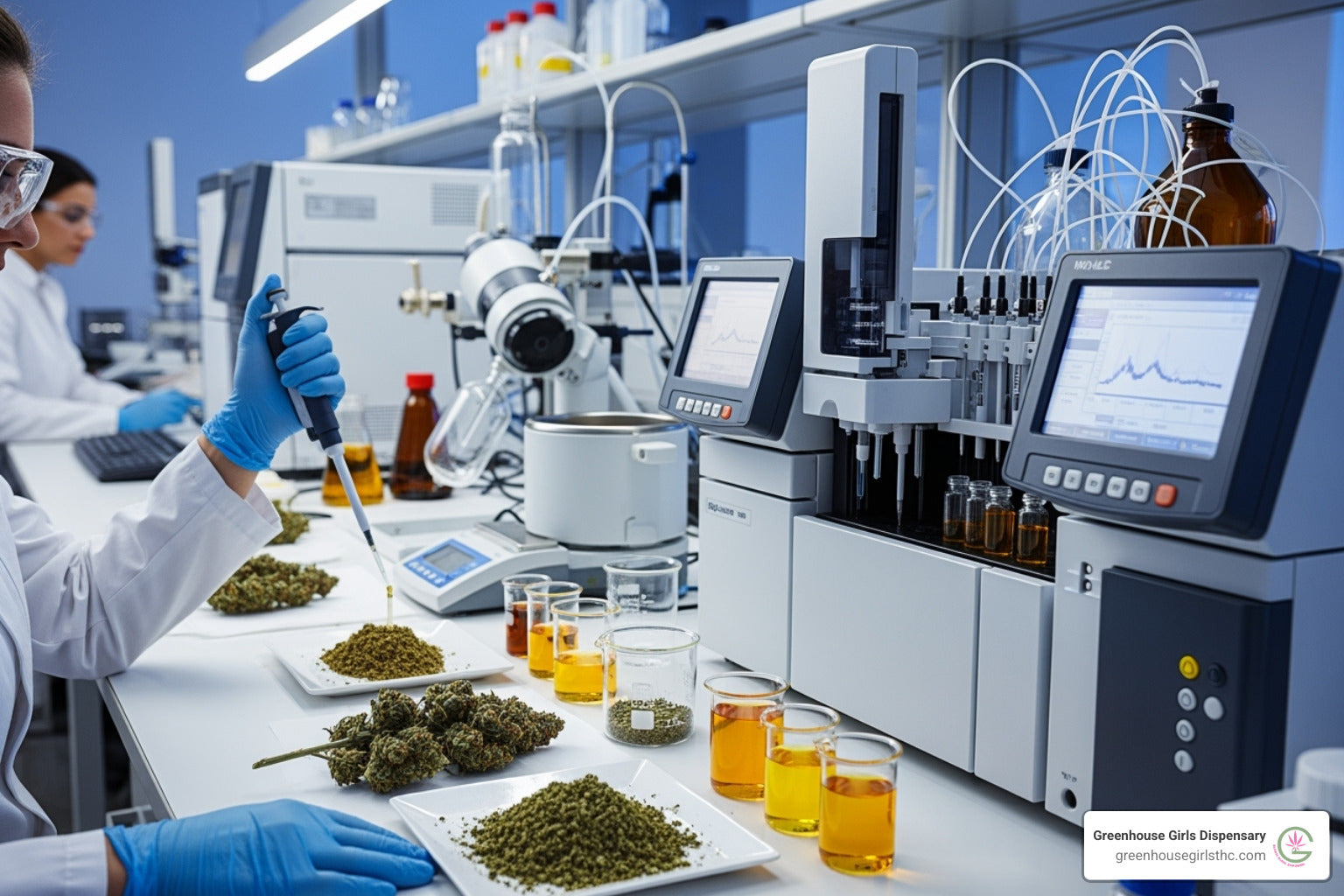
A Practical Guide to Lab Tested Cannabis
Introduction: Why Trust What You Consume?
Lab tested cannabis ensures your products are safe, potent, and accurately labeled through rigorous scientific analysis. Here's what makes it the gold standard:
Key Benefits of Lab Tested Cannabis:
- Safety: Screens for harmful pesticides, heavy metals, mold, and bacteria
- Accuracy: Confirms exact THC, CBD, and terpene levels
- Consistency: Guarantees product matches what's on the label
- Peace of Mind: Third-party verification you can trust
The cannabis industry has evolved beyond the unregulated "dark ages." Rapid growth created a "gold rush" where many companies skipped testing due to a lack of oversight, putting consumers at risk.
The stakes are real. Unregulated cannabis can contain dangerous levels of contaminants that pose serious health risks. That's why states like Colorado pioneered mandatory testing in 2015, requiring potency and microbial screening for all products.
When you choose lab tested cannabis, you're choosing transparency over uncertainty. You get detailed Certificates of Analysis (COAs) showing exactly what's in your product—from cannabinoid percentages to safety screenings.
I'm Selena Jochumsen of Greenhouse Girls. Through my work with the National Cannabis Industry Association's Hemp Committee, I've seen how lab tested cannabis protects consumers and builds trust. My mission is to help you steer this landscape with confidence.
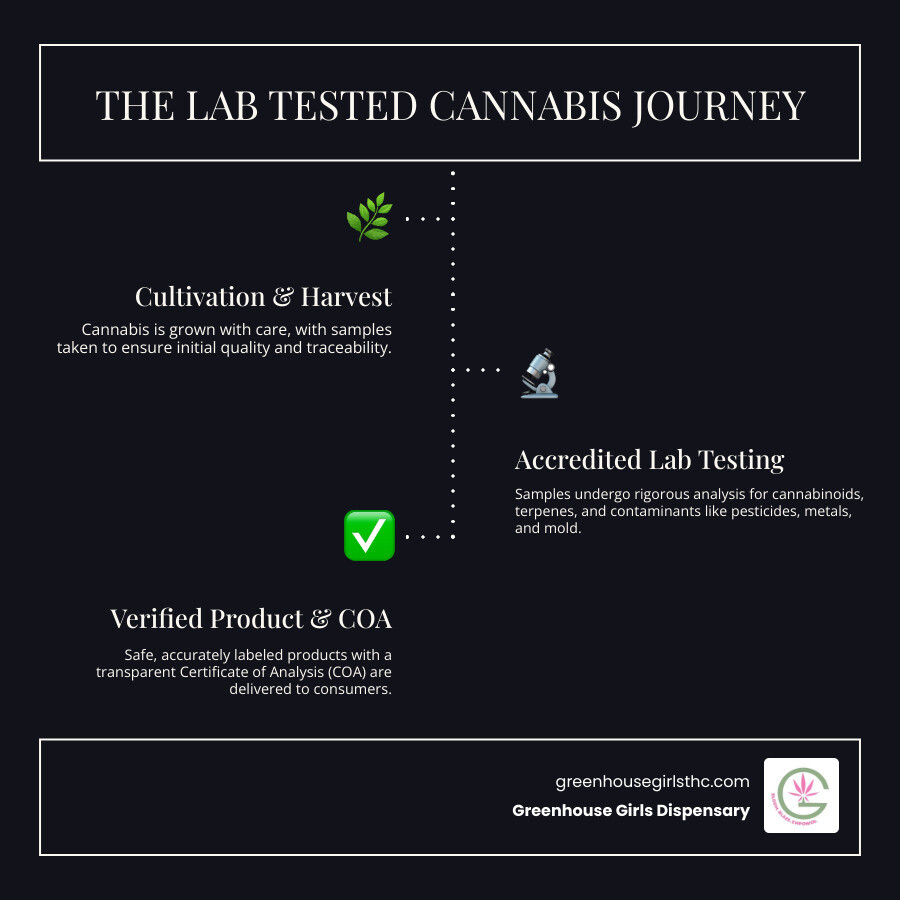
The Comprehensive Process of Lab Tested Cannabis
Lab tested cannabis isn't just a label; it's a guarantee that your product has undergone a rigorous scientific journey. Think of it as a full physical for your cannabis, analyzing it for both the good stuff you want and the bad stuff you don't.
Why Lab Tested Cannabis is the Gold Standard for Safety
The early cannabis industry was risky. Without proper testing, you never really knew what you were getting.
Potency inflation was rampant. A product might claim 25% THC but actually contain 15%—or worse, 35%. This meant unpredictable experiences for recreational users and incorrect dosing for medical patients.
The safety risks were even scarier. A 2013 investigation found that unregulated marijuana could be "covered in mold, E.coli, insect parts and pollutants."
That's why states like Colorado stepped up in 2015, making potency and microbial testing mandatory. Washington followed suit in 2022, adding routine pesticide and random heavy metal testing. These regulations were direct responses to real health risks, boosting consumer confidence and ensuring medical patient safety. Quality control benefits everyone.
Cannabinoid and Terpene Profiling (The "Good Stuff")
This is where labs analyze the compounds that make cannabis unique, creating a detailed chemical fingerprint of your product.
Potency testing starts with the big players: THC (the psychoactive compound), CBD (the therapeutic superstar), and THCA (THC's non-psychoactive precursor that activates with heat). Accurate numbers help you choose the perfect product for your needs.
Our THCA flower is a perfect example. Until heated, THCA isn't psychoactive. When you light it up, it converts to THC.
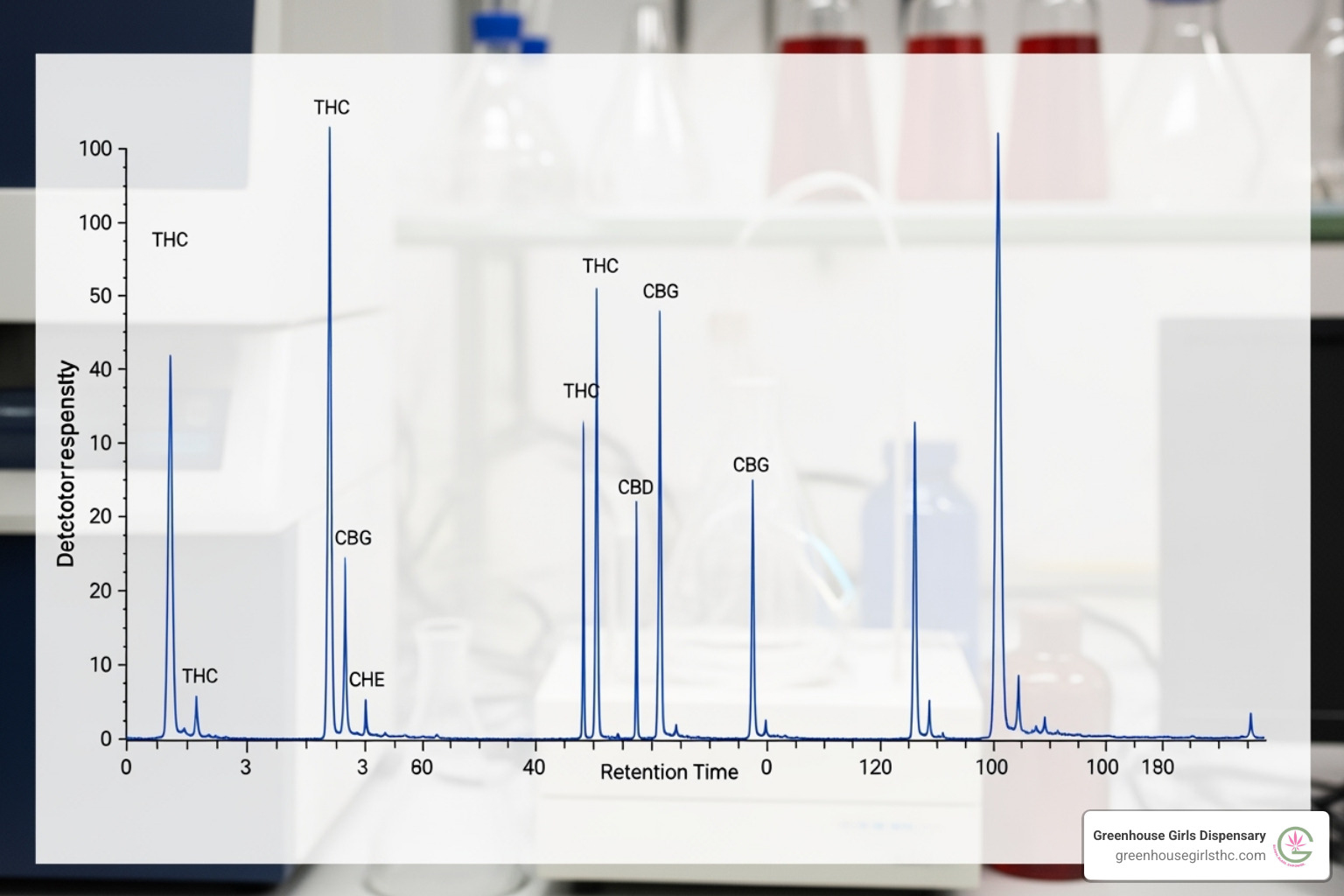
Terpene analysis takes things to the next level. These aromatic compounds create the product's scent and work with cannabinoids in what's known as the entourage effect, where each compound improves the overall performance.
Labs use techniques like High-Performance Liquid Chromatography (HPLC) for cannabinoids and Gas Chromatography-Mass Spectrometry (GC-MS/MS) for terpenes. These precise tools help us deliver consistent, predictable products.
Contaminant Screening (The "Bad Stuff")
This crucial step ensures nothing harmful has snuck into your cannabis.
- Pesticides: While they protect crops, they can be toxic when concentrated. Labs screen for even trace amounts.
- Heavy metals: Lead, mercury, and arsenic can be absorbed from soil. We test down to parts per trillion.
- Mycotoxins, Mold, and Yeast: We check for microscopic spores that could cause problems, especially for those with compromised immune systems.
- E. coli and other bacteria: Advanced DNA and culture testing catches dangerous bacteria.
- Residual solvents: Leftover butane or propane from extraction processes must be completely purged.
- Water activity: This measures unbound water, which relates to spoilage risk and shelf life.
As noted in "Cannabis Compliance Testing: Safety vs. Quality", good testing balances safety and quality. At Greenhouse Girls, we exceed minimum standards because you deserve the cleanest, safest products possible. Every product, from our shake deals to our 25mg Delta-9 gummies, passes this comprehensive testing gauntlet. That's the lab tested cannabis difference.
The Rules of the Road: Regulations and Accreditation
Cannabis regulations can feel overwhelming, but they aren't just red tape. They are the foundation that makes lab tested cannabis possible and protects consumers. Without them, we'd still be in the wild west of questionable quality.
State-by-State Regulatory Patchwork
The path to legal cannabis has resulted in a patchwork of laws. Since Colorado led the way in 2012, each state has developed its own policies.
Every state writes its own rulebook for cannabis testing, creating a complex web of requirements. Colorado pioneered mandatory potency and microbial testing in 2015. California followed with its own standards, and Washington State raised the bar in 2022 by adding routine pesticide and random heavy metal screening.
This state-by-state approach creates challenges but also drives innovation as states learn from each other. This complexity is why lab tested cannabis is so important. We steer these regulations so you can focus on finding the right products. For those interested in how these rules affect hemp-derived products, check out our guide on Florida THCA Delivery.
The Role of Accreditation: ISO/IEC 17025
Lab accreditation helps you identify which labs are competent. It's a quality stamp of approval.
The gold standard for testing labs is ISO/IEC 17025. This rigorous standard covers everything from staff training to equipment maintenance, ensuring a lab can deliver accurate, reliable results consistently.
Organizations like A2LA (American Association for Laboratory Accreditation) are the watchdogs who ensure labs meet these high standards, with a specific focus on cannabis and hemp testing.
Accreditation isn't a one-time deal. Labs must participate in third-party proficiency testing, where they test mystery samples to verify their accuracy. When a lab is ISO/IEC 17025 accredited, you can trust their lab tested cannabis results. They've proven their competence to independent experts. For more details, you can review the official ISO/IEC 17025 accreditation standards.
Hemp vs. Marijuana Testing: What's the Difference?
Both hemp and marijuana come from the Cannabis sativa L. plant, but the law treats them differently based on one number: 0.3% Delta-9 THC.
Hemp is federally legal under the 2018 Farm Bill because it stays below this threshold. This opened the door for products like CBD, CBG, and THCA flower. Marijuana crosses that line and is subject to stricter state regulations.
This legal distinction changes the testing game. For hemp, testing focuses on USDA hemp compliance, ensuring Delta-9 THC is below 0.3%. This often involves both pre-harvest and post-harvest testing. Marijuana testing is typically more comprehensive due to higher potency and stricter state rules.
| Test Category | Hemp-Derived Products | Marijuana-Derived Products |
|---|---|---|
| Cannabinoid Potency | Mandatory (Delta-9 THC < 0.3%) | Mandatory (full cannabinoid profile) |
| Terpene Profile | Optional but recommended | Often mandatory |
| Pesticides | Mandatory in most states | Mandatory in all regulated states |
| Heavy Metals | Mandatory in most states | Mandatory in all regulated states |
| Mycotoxins | Mandatory in most states | Mandatory in all regulated states |
| Microbial Contaminants | Mandatory in most states | Mandatory in all regulated states |
| Residual Solvents | Mandatory for extracts | Mandatory for extracts |
| Water Activity | Often mandatory for flower | Often mandatory for flower |
At Greenhouse Girls, we specialize in federally legal, hemp-derived cannabis. Our lab tested cannabis—from THCA flower to Delta 9 gummies—strictly adheres to the 0.3% Delta-9 THC limit while delivering the quality you expect.
Decoding the Data: How to Read a Certificate of Analysis (COA)
A Certificate of Analysis (COA) is a product's report card, detailing what's inside your cannabis. Reading a COA empowers you to make smart choices about your lab tested cannabis. Once you know what to look for, it's simple.
Key Sections of a COA
Every COA we provide for our products follows a standard format. These documents have become essential to the industry.
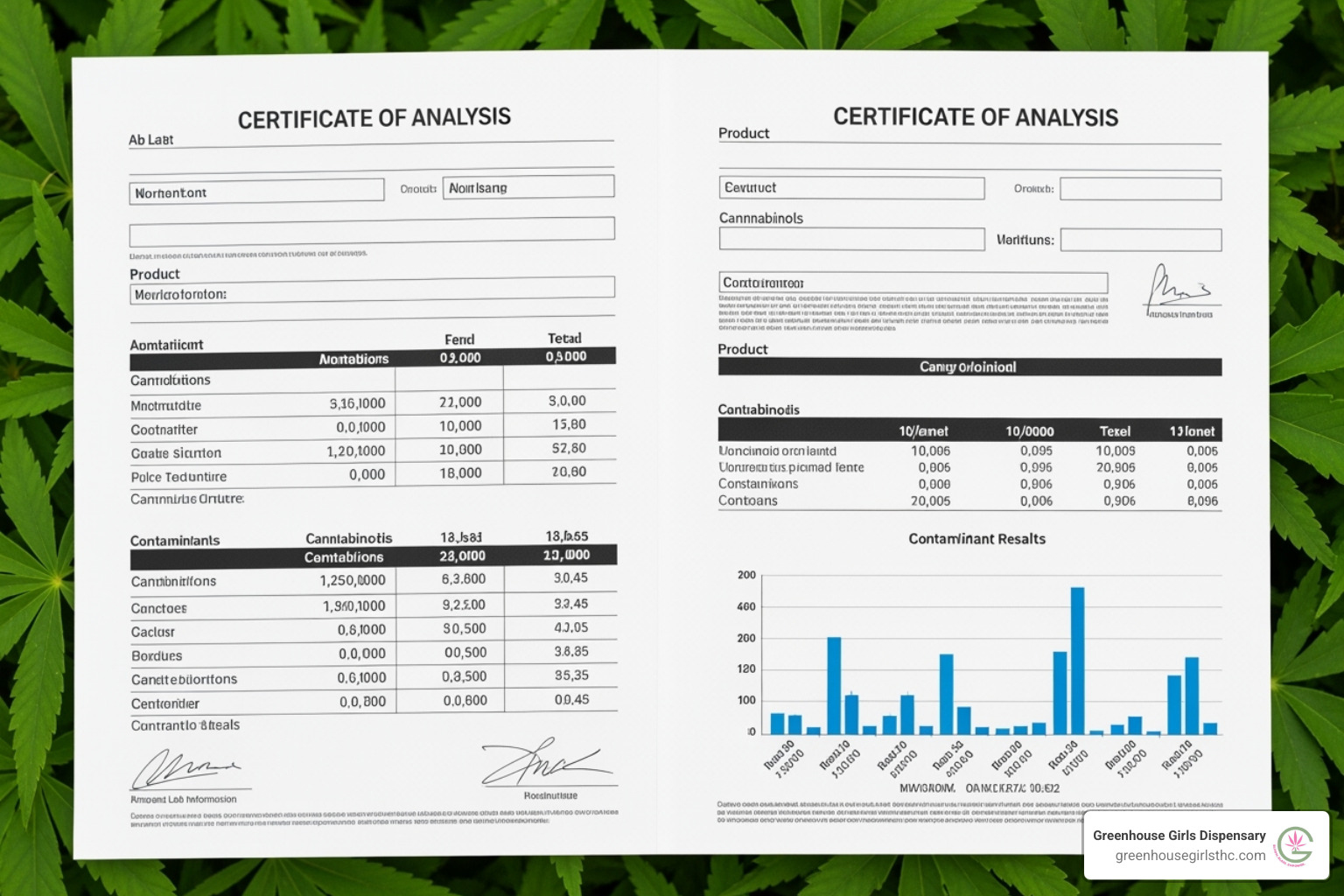
- Lab Information: Shows which accredited lab performed the tests, including their accreditation number (e.g., ISO/IEC 17025).
- Client and Product Details: Confirms who submitted the sample (like Greenhouse Girls) and what product was tested.
- Batch or Lot Number: This unique ID connects the COA to the specific product in your hands. Always ensure this number matches your package.
- Cannabinoid Profile: Lists cannabinoids (THC, THCA, CBD, etc.) and their concentrations, showing the product's true potency.
- Terpene Profile: Reveals the aromatic compounds responsible for the product's unique smell, flavor, and effects.
- Contaminant Results: Covers safety screenings for pesticides, heavy metals, microbials, residual solvents, and more, usually with a "Pass" or "Fail" result.
Understanding Potency and Purity Results
Decoding the numbers is key to understanding lab tested cannabis data.
For our THCA flower, you'll see high THCA but low Delta-9 THC. To estimate the total potential psychoactive effect, use this formula: Total THC = (THCA × 0.877) + Delta-9 THC. This accounts for the conversion of THCA to THC when heated.
Cannabinoid percentages show the amount by weight. 20% THC means 200 milligrams of THC per gram. For edibles like our gummies, you'll see milligrams per serving or package.
Pass/Fail results for contaminants are straightforward. "Pass" means any detected levels are safely below state limits. "Fail" means the product exceeded those limits and cannot be sold.
Action levels are the maximum allowed amounts of contaminants. "ND" (Non-Detect) is excellent news, meaning the lab couldn't find that contaminant.
Want to dive deeper? Check out our guide: Beyond the Buzz: What Your Cannabis Lab Test Results Really Mean.
Choosing Products Based on Lab Tested Cannabis Results
Now that you can read a COA, use this knowledge to choose the best lab tested cannabis products.
Quality brands, including Greenhouse Girls, put QR codes on the packaging. Scan it with your phone to go directly to that product's COA. If there's no QR code, look for a "Lab Results" section on the brand's website where you can search by batch number.
Watch out for red flags:
- Inconsistent data or unprofessional-looking COAs.
- Missing tests (a full COA has both potency and safety results).
- Outdated results (COAs should be recent).
- Testing done by an in-house lab instead of an independent, accredited third-party lab.
At Greenhouse Girls, we make accessing COAs simple for all our products, from THCA flower to our 25mg Delta 9 gummies. We even have info on specialized products like THCA dabs. An informed customer is a confident one.
The Future of Cannabis Testing
The cannabis industry is moving at warp speed, from a "wild west" market to a sophisticated industry built on science. The future of lab tested cannabis promises more developments and a few challenges.
Emerging Trends and Challenges
Chemometrics is an emerging field that aims to predict a product's effects based on its complete chemical fingerprint, going beyond simple THC percentages. It analyzes the complex chemical relationships to reveal how compounds work together to create a unique experience.
We're also seeing advances like yeast and mold DNA testing. These methods can identify specific harmful organisms faster and more precisely than traditional methods, improving safety.
However, challenges remain. The biggest is the lack of federal standardization. With different rules in every state, it's complex for businesses and confusing for consumers. This has led to "lab shopping," where producers seek labs that provide favorable results, undermining the integrity of lab tested cannabis. As noted in "The analytical landscape of cannabis compliance testing," continuous improvement in testing methods is essential.
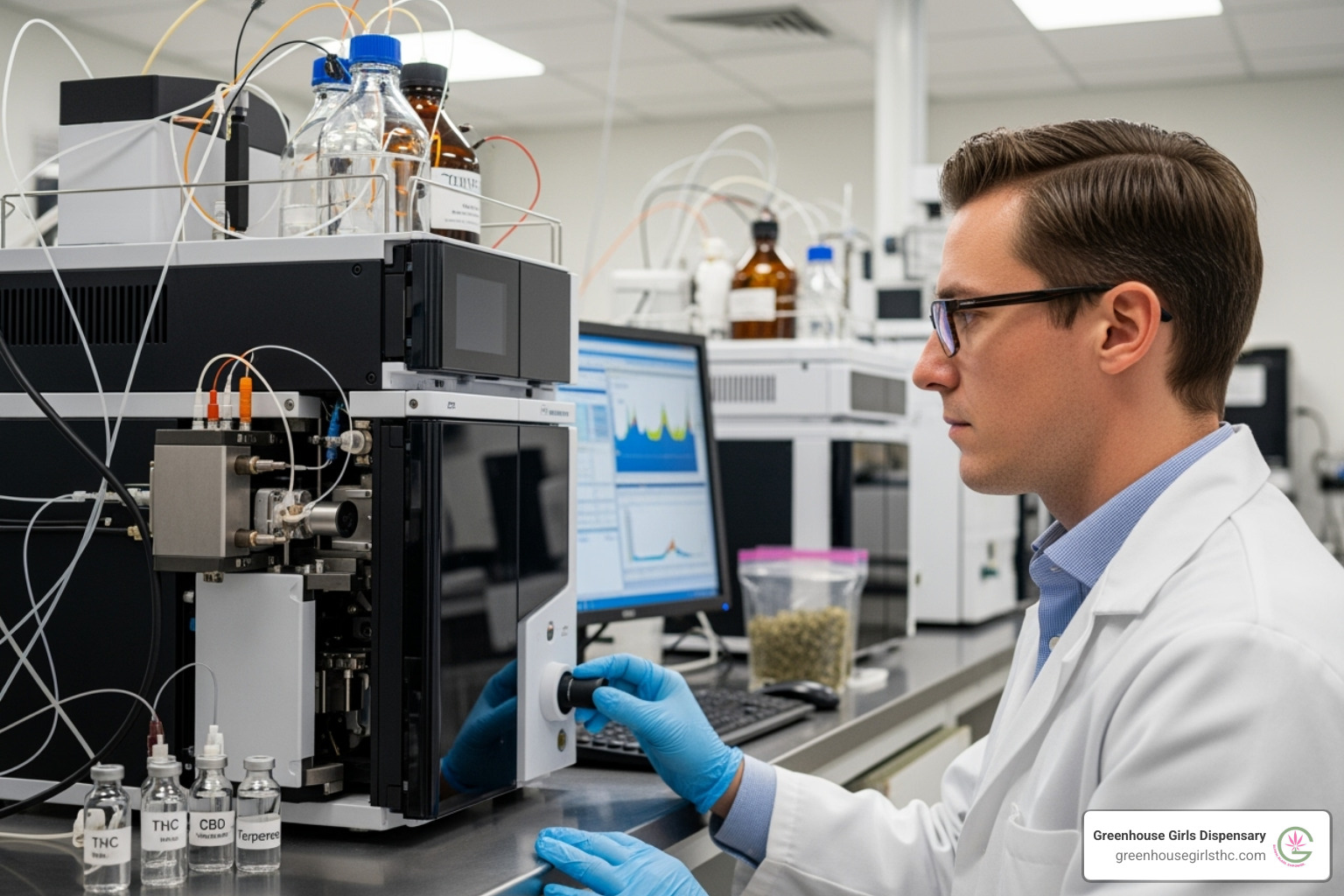
Beyond Indica and Sativa: The Push for Chemical Profiling
The classic "Indica" and "Sativa" labels are scientifically inaccurate. The industry is finally catching up to the science.
The real magic is in chemical profiling, specifically understanding terpenes. These aromatic compounds direct how other compounds work together. Instead of guessing an "Indica" will be sleepy, terpene-based effects allow for precise predictions. A strain rich in myrcene might promote relaxation, while one with limonene could provide a creative boost.
This shift toward chemovar classification is revolutionizing cannabis. As Alec Dixon noted in "A Cannabis Manifesto: It's Time to Retire the Words \"Indica\" and \"Sativa\"", it's time to move beyond these outdated labels.
Educating consumers about terpenes is crucial. We want you to feel confident reading COAs and understanding what myrcene or pinene means for your experience. At Greenhouse Girls, we accept this future. Our detailed chemical profiles help you find exactly what works for you, creating a truly personalized lab tested cannabis experience.
Conclusion: Making Confident Cannabis Choices
Lab tested cannabis is the cornerstone of a safe and transparent market. Understanding the testing process, regulations, and how to read a Certificate of Analysis (COA) is key. This knowledge is your superpower, allowing you to make informed choices that prioritize your health and safety over flashy marketing.
At Greenhouse Girls Dispensary, transparency is how we do business. We provide accessible COAs for every federally legal, hemp-derived product we offer. Whether you're exploring our flower (like our popular shake deals), enjoying our precisely dosed gummies (25mg D9 and 50mg D8), or trying our convenient prerolls, you can be confident that everything comes from small family farms and passes rigorous testing.
Our commitment to lab tested cannabis covers our entire product line, including edibles, vapes, drinks, and 420 merch. We know you want peace of mind when choosing hemp-derived cannabis.
Whether you visit us in Palm Harbor or Oldsmar, Florida, or use our nationwide shipping, you'll experience the difference transparency makes. We're so confident in our quality that we offer a free preroll or gummy with your first visit.
By choosing lab tested cannabis, you're not just protecting yourself—you're supporting an industry that values safety, quality, and honesty.
Your Digital Dispensary: The Best Places to Buy THCA Online
Ready to experience high-quality, lab tested cannabis from home? Our online store brings the best directly to you with the same commitment to transparency and quality. Learn how we're revolutionizing online cannabis shopping: Your Digital Dispensary: The Best Places to Buy THCA Online.
Still have questions? We've got you covered with our comprehensive guide: Learn the difference between hemp-derived and marijuana-derived cannabis. We're here to guide you on your cannabis journey.

